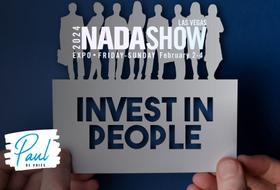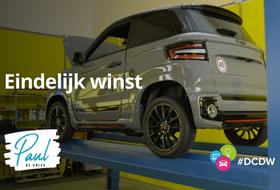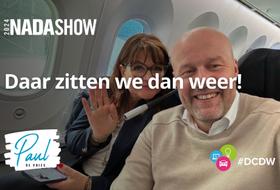
What is your best price without trade-in?
26 februari 2018, PaulHow do you deal with questions about the best price?

In many of my seminars I do a short research a few days before the meeting. I try to find out how companies (unfortunately you cannot reach sellers directly via a portal) respond to a specific question from a consumer about a used stock car. The results are often disappointing, but fortunately there are also good reactions. They are even so good that others can learn something from it.
Anneke
In my research I use Anneke van Vliet as my pseudonym (I now have to look for another one) and that name is linked to the following e-mail address: annekevanvliet1974@gmail.com. Anneke always sends her concrete purchase request with ‘Anneke’ as sender. You may carefully assume (yes, I know, a dangerous conclusion) that Anneke was born in 1974, but that she likes to be called ‘Anneke’. A small obstacle appears here. A 24-year-old salesman is often approached differently than a salesman of say 44 years. The latter simply has more credit because of his age. The intention is therefore that the seller ‘reads’ the lead and gets the right tone.
Anneke has even more ‘quirks’ in her communication process with the company. For example, Anneke never leaves a telephone number, and if that is necessary because it is a mandatory field, she enters the number 06-12345678. Anneke does not do that because she is not serious, but because she wants to keep control over the contact with the company as long as possible. Anyone who thinks that a customer without a phone number is not serious is a complete idiot in this time. Anneke, with her specific approach, is the basis of my simple research.
Response times
The response times to Anneke’s messages are usually fine. A large number responded within an hour, only about 7% of the companies surveyed did not respond at all. Excellent score, even though 7% is still 7% too much. The industry makes clear steps. Anneke never responds to e-mails, and precisely those follow-up e-mails are a concern! Only 20% (!!!) of the companies surveyed send a second e-mail to Anneke. In fact, we say that if Anneke does not respond to the first, meaningless e-mail, she cannot be serious. A totally wrong conclusion. The only correct conclusion is that you are not serious about your profession. Apparently the sellers are only interested in the simple scoring opportunities…. If Anneke does not respond to the second e-mail, then less than 5% of the companies surveyed are sending a third e-mail. After that, the seminar takes place and they know who Anneke really is.
We know that the average buyer of a used car is ‘in the market’ for two weeks after the lead has been sent. Every follow-up process about a used car must therefore cover at least two weeks. Giving up after 1, often not very well written, e-mail is definitely not right if you are not the cheapest. Too many used cars are sold because they are cheap, not because of the good follow-up by a salesman.
The received e-mails
I would like to show you a few e-mails that I have received as Anneke. I have made some comments here and there.
Two things stand out. First, the customer is thanked for the interest in a large part of the e-mails. That is neat. On the other hand, most e-mails answer the question, but do not ask a question themselves (Online Rule # 3: always close with a question). One acts too much as an answering machine instead of a sales device for appointments.
Example 1
Dear Anneke,Thank you for your interest.
In case of no trade-in and based on taking the car as it is, the price will be € 13.500, -. Or € 13.940, – with 6 months warranty and a service.
We would like to invite you for a viewing.Kind regards,
Sent from my iPhone
This answer is fine in itself, but he could have done better by asking a question. For example about when the viewing takes place. Immediately give a number of options when you have time, and make it particularly clear what the customer’s advantage is to come in and see the car. Something like: ‘My experience tells me that many of our customers would like to see the car for themselves and take a test drive to get a real feeling with the car. When would you be able to come by? Will it fit tomorrow, or rather Saturday?
Example 2
Dear Anneke,Thank you for your interest in our used Seat Alhambra.
Car is fully prepared, including 4 new tires and a service.
What is an acceptable price for you that we can talk about?
Do not hesitate to call, communicates a lot easier that thru the mail.
In the second example, a lot goes wrong. Not only the spelling rattles, but also the style can be better. You are sending this like you are talking about a package of butter instead of a car. The question to call is fine, but Anneke has consciously chosen not to give a phone number, so what is the advantage for her to call? Make that clear. Something like: ‘My experience shows that if I can discuss your wishes and demands by telephone, I can offer you interesting alternatives. Please call me? Or would you prefer me to call you? In that case, I need your telephone number.
Example 3
Good morning,Thank you for your response to the car. May I call you later? What is your number?
Sincerely,Speed is important. This response came back in no time. He is fast, but also bad. If you had read the lead, you could have known that the customer has a name and that she has deliberately left no phone number. What is the advantage for the customer to call? Asking for a phone call is fine, but with two questions and without a reason there is no chance. If the customer does not respond, this has nothing to do with the customer, but everything with the response of the company.
Again, customers often accept a lot if you are the cheapest. In that case, the customer will take the trouble, but the seller – and therefore the company – will not get better. And when someone else is cheaper, nobody knows which button to turn to get a more constant and better lead follow-up.
Example 4
Dear Mrs Van Vliet,
Thank you for your interest in the Peugeot 207. Unfortunately you didn’t give me your telephone number, which is why I approach you by e-mail.In view of your interest in the BRAND / MODEL, I would like to invite you for an appointment at one of our locations, if possible. Here, we would like to discuss the price of the vehicle. You can also view the car of your interest during this appointment and of course a there is the possibility of a test drive. If you prefer telephone contact, I would like to receive the telephone number where you can be reached. I can be reached easily by e-mail or by phone at 0000000000.
Excellent response, as it should be. The advantages for the customer to come to the location of the dealer are appointed (price negotiation, view car, test drive). Can this reaction be better? Yes, because Online Rule # 3 is missing. So also close this message with a question….
Example 5
Dear Anneke,Thank you for your interest in the BRAND / MODEL we offer.
We could give the delivery package as a discount. In that case, the price remains € 11,200.
The delivery package includes the following:
Service & Warranty package € 495, – or € 695, – (most chosen):
The car will be delivered with:
· MOT inspection with a minimum of 11 months validity
· € 25,- fuel
· Cleaning
· Full vehicle inspection based on MOT standards
· Liquid control (oil, coolant, windscreen washer fluid)
· Full delivery
· 12 months mobility guarantee / breakdown service (only for HQP cars)Would you like to see the car?
Neat answer, the benefits for the customer are appointed and a question is asked. Excellent basis for the follow-up!
Price is an excuse
Too many sellers are getting stressed when there is a lead that asks for the best price, makes a bid that is too low or asks other price-related questions. Giving a simple answer and hope for the best does not work. What does work? See every mail, including the price, as the starting point of a dialogue. Enter the conversation, understand that the first conversion must be a meaningful dialogue. This dialogue can be done by e-mail or telephone.
The second conversion is a concrete appointment. Only then will you sell the car.
On 100 leads you are the most successful if you do not want to be the cheapest… If you think that only the price sells, then look around your house to find things for which you haven’t paid the lowest price. Believe me, that’s more stuff than you think. Price is an excuse, it rarely makes you better!
About Paul de Vries
Paul de Vries became a Key Automotive Spokesperson at eBay (Marktplaats) after selling Nieuweautokopen.nl to eBay back in 2015. Paul is the founder and CEO of the #DCDW Academy and the presenter of the #DCDW Podcast. He is also a by dealers and importers frequently asked speaker in the online automotive industry. Paul is the winner of the prestigious Lighthouse Award 2016 in the U.S.! `Lead the Way op de digitale snelweg’ is Paul’s new book, which can be used as a guide in the online automotive industry. More information is available at: DCDW.nl.





